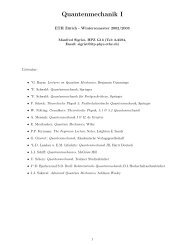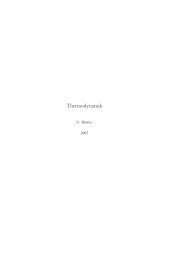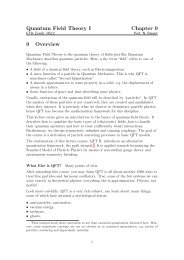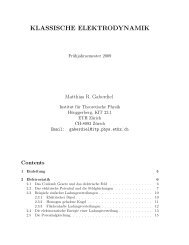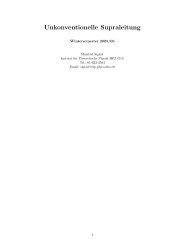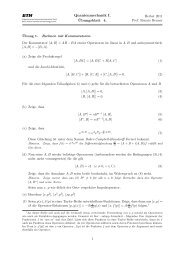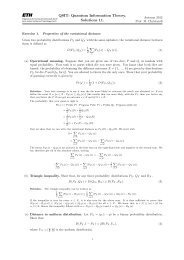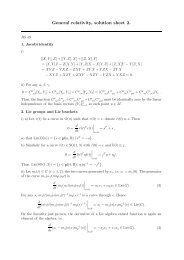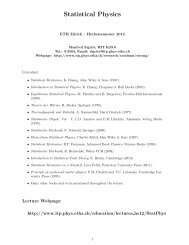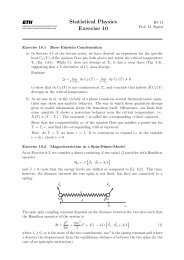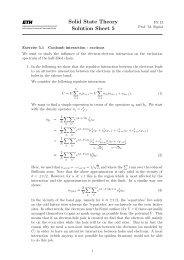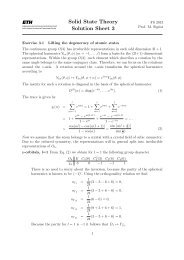Statistical Physics Exercise Sheet 10
Statistical Physics Exercise Sheet 10
Statistical Physics Exercise Sheet 10
You also want an ePaper? Increase the reach of your titles
YUMPU automatically turns print PDFs into web optimized ePapers that Google loves.
<strong>Statistical</strong> <strong>Physics</strong><br />
<strong>Exercise</strong> <strong>Sheet</strong> <strong>10</strong><br />
HS 07<br />
Prof. M. Sigrist<br />
<strong>Exercise</strong> <strong>10</strong>.1<br />
The Lattice Gas model<br />
The lattice gas model is obtained by dividing the volume V into microscopic cells which<br />
are assumed to be small that they contain at most one gas molecule. We neglect the<br />
kinetic energy of a molecule and assume that only nearest neighbors interact. The total<br />
energy is given by<br />
H = −λ ∑ 〈i,j〉<br />
n i n j (1)<br />
where the sum runs over nearest-neighbor pairs and λ > 0 is the nearest-neighbor attraction.<br />
We assume a hard-core potential, meaning that there can be no more than one<br />
particle in each cell and therefore n i = 0 or 1. This choice of the interaction is a caricature<br />
of the Lenard-Jones potential.<br />
Figure 1: Schematic view of the lattice gas model.<br />
a) Show the equivalence of the grand canonical ensemble of the lattice gas model with<br />
the canonical ensemble of an Ising model in a magnetic field.<br />
In the following we will use the mean-field solution of the Ising model discussed in Chapter<br />
5.2 of the lecture notes and the equivalence stated in a) in order to discuss the liquid-gas<br />
transition in the lattice gas model.<br />
b) Derive a self-consistence equation for the density ρ = 〈n i 〉 and discuss its solutions<br />
as a function of the temperature T and chemical potential µ.<br />
c) Find the equation of state p = p(T, ρ) or p = p(T, v) and discuss the liquid-gas<br />
transition in the p − v diagram. Thereby, v = 1/ρ is the specific volume.<br />
d) Find the phase diagram (T − p diagram). Determine the phase boundary (T, p c (T ))<br />
and, in particular, compute the critical point (T c , p c (T c )).<br />
Please turn over.
<strong>Exercise</strong> <strong>10</strong>.2<br />
Magnetic domain wall<br />
We want to calculate the energy of a magnetic domain wall in the framework of the<br />
Ginzburg-Landau (GL) theory. We assume translational symmetry in the (y, z)-plane in<br />
which case the GL functional in zero field reads<br />
∫ { A<br />
F [m, m ′ ] = F 0 + dx<br />
2 m(x)2 + B 4 m(x)4 + κ }<br />
2 [m′ (x)] 2 . (2)<br />
a) Solve the GL equation with boundary conditions<br />
m(x → ±∞) = ±m 0 , m ′ (x → ±∞) = 0. (3)<br />
Here, m 0 is the magnetization of the uniform solution.<br />
b) Compute the energy of the solution in a) as compared to the uniformly polarized<br />
solution. Use the coefficients A and B according to the expansion of the mean-field<br />
free energy of the Ising model [see Eq. (5.64)]. Compare the energy of the domain<br />
wall with the energy of a sharp step in the magnetization.



